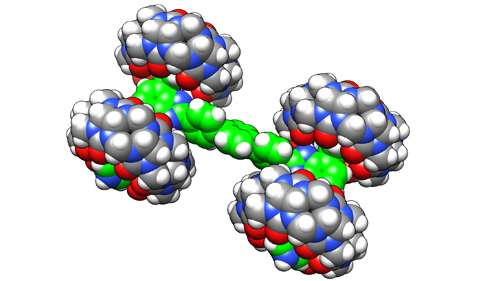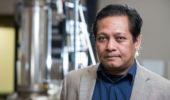
Ohio University team’s molecular car design concept, the “OHIO Bobcat nano-Wagon”
What is the smallest mechanical machine that can be built? Since the building blocks of our material word are atoms, it’s easy to imagine a machine built from just a handful of atoms. That’s easier said than done. But with recent advances in technology, it’s now possible to take a small cluster of atoms and make them rotate on a molecular axis. In fact, the 2016 Nobel Prize in Chemistry was awarded “for the design and synthesis of molecular machines.”
At Ohio University, Dr. Saw-Wai Hla, Professor of Physics & Astronomy, has been spearheading research into this same topic. A few years ago, Hla and his students demonstrated the first controlled directional rotation of molecular clusters on a gold surface, which was published in the journal Nature Nanotechnology. More recently, in collaboration with colleagues from France, Hla was able to show the simultaneous rotation of up to 500 molecular motors on a gold crystal surface, which was published just this year, also in Nature Nanotechnology.
Now Hla, along with Dr. Eric Masson, Associate Professor of Chemistry & Biochemistry, have synthesized four-wheel molecular nanocars (shown in the figure above) and will compete in the International NanoCar Race, sponsored by France’s National Center for Scientific Research in spring 2017.
The entry by Ohio University is one of just six groups in the world that will compete in “driving” the cars along a slalom-like track on a gold surface using the tip of a scanning tunneling microscope (STM) to provide the propulsion.
“The whole competition is not just about building the car…. We are trying to develop a technology to transport at the molecular scale,” Hla said.

Dr. Saw-Wai Hla
Masson’s team of graduate students is constructing the race car while Hla’s team will drive the car. Masson explained that the nanocar is made of two types of organic molecules: an H-shaped frame and four “wheels” made of a molecular grouping called a Cucurbituril. The name comes from the resemblance of these molecules to pumpkins, which are members of the Cucurbitaceae family of plants. “There’s no chemical bond between the frame and the wheels, so the frame is really floating into the wheels,” Masson said.
Given their design, the biggest challenge will be ensuring that the frame stays in place, Masson said. He said that a wheel may potentially fall off during the race and the team would have to rebuild the car on the gold surface to continue. “In fact, we would be absolutely delighted if that incident were to happen during the race!” he said, noting that that reconstruction process has never been published.

Dr. Eric Masson
While Masson’s team is working on the chemical synthesis of the car, Hla’s team is strategizing how to drive a car that does not have a steering wheel. Hla explained that the car will be driven by using the electric field energy supplied from the tip of an STM. The tip is a nanosized metal needle with an applied voltage. Several test drives are necessary to ensure the car will move according to plan.
Maintaining the temperature of the molecules is also essential. If the molecules get too hot, they will not stop moving. So, the car has to be cooled using helium to -400 degrees Fahrenheit prior to the race.
The event will be filmed live, showing photo images captured at various points in the race via the STM. If Ohio University wins, they will receive worldwide recognition. But of course the real prize is proving that science can make almost anything seem possible.
View the complete 2015-16 newsletter as a pdf.



















Comments